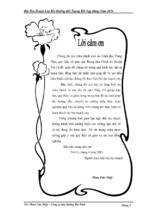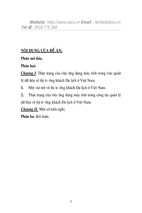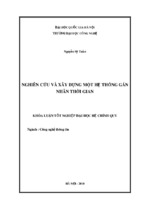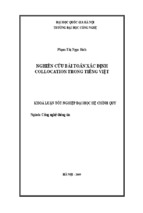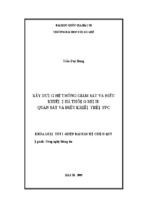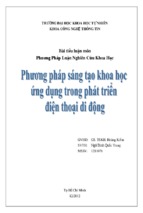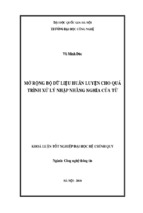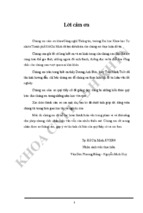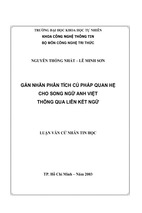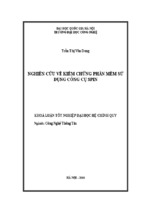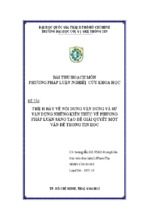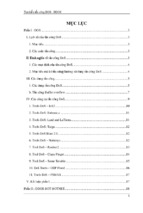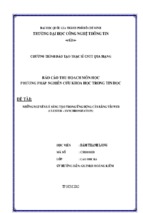Akewak Jeba
Digital Image Processing
and Image Restoration
Helsinki Metropolia University of Applied Sciences
Bachelor of Engineering
Information Technology
Thesis
May 5, 2011
2
Abstract
Author(s)
Akewak Jeba
Title
Digital image processing and image restoration
Number of Pages
61 pages + 6 appendices
Date
5 May 2011
Degree
Bachelor of Engineering
Degree Programme
Information Technology
Specialisation Option
Embedded Engineering
Instructor(s)
Jarkko Vuori
The main goal of the project is to analyze the methods of digital image processing
that are used to enhance an image. This project included the main concept of digital
image processing, how to process it using some techniques and compare the
techniques and suggest which one is easy to deal with digital images. The targets of
the techniques include reducing noise, contrast enhancement and image sharpening.
This project also analyzed the methods on color images and suggested the ways in
order to restore images.
The method used to carry out the project was MATLAB software. Mathematical
algorithms were programmed and tested for the result to find the necessary output.
In this project mathematical analysis was the basic core. Generally the spatial and
frequency domain methods were both important and applicable in different
technologies. This project has tried to show the comparison between spatial and
frequency domain approaches and their advantages and disadvantages. This project
also suggested that more research have to be done in many other image processing
applications to show the importance of those methods.
Spatial domain, frequency domain, low-pass filter, high-pass
Keywords
filter, noise reduction, image processing, image restoration
3
Contents
Abstract ............................................................................................................................ 2
Table of Symbols ............................................................................................................ 5
1 Introduction .................................................................................................................. 6
2 Theoretical Background .............................................................................................. 7
2.1 Fundamentals of Digital Image Processing ...................................................... 7
2.2 Basics of Image Sampling and Quantization ................................................... 8
3 Spatial Domain Image Enhancement and Transformation ................................. 10
3.1 Gray Level Transformation ............................................................................... 10
3.2 Histogram Processing ........................................................................................ 13
3.2.1 Histogram Representation ......................................................................... 13
3.2.2 Histogram Equalization .............................................................................. 14
3.2.3 Histogram Matching ................................................................................... 18
3.3 Image Subtraction ............................................................................................. 18
3.4 Image Averaging ................................................................................................ 20
3.5 Spatial Filtering ................................................................................................... 22
3.6 Smoothing Spatial Filter .................................................................................... 22
3.7 Median Filtering .................................................................................................. 24
3.8 Sharpening Spatial Filter ................................................................................... 26
3.8.1 The Laplacian Method ................................................................................ 27
3.8.2 The Gradient Method ................................................................................. 29
4 Frequency Domain Image Enhancement............................................................... 31
4.1 Fourier Transform .............................................................................................. 31
4.2 The Discrete Fourier Transform ....................................................................... 31
4.3 Smoothing Frequency Domain Filter ............................................................... 34
4.3.1 Ideal Low-pass Filter .................................................................................. 34
4.3.2 Butterworth Low-pass Filter ...................................................................... 37
4.4 Sharpening in Frequency Domain ................................................................... 38
4
4.4.1 Ideal High-pass Filter ................................................................................. 39
4.4.2 Butterworth High-pass Filter ..................................................................... 40
5 Image Restoration ..................................................................................................... 41
5.1 Noise Types......................................................................................................... 41
5.2 Noise Filtering in Spatial and Frequency Domain ......................................... 44
6. Analysis of Spatial and Frequency Methods and Results ................................... 50
6.1 Analysis of Spatial Image Filtering .................................................................. 50
6.2 Analysis of the Frequency Domain .................................................................. 50
7 Conclusion .................................................................................................................. 58
References ..................................................................................................................... 59
Appendices ..................................................................................................................... 61
Appendix 1 ................................................................................................................. 61
Spatial domain Algorithms ................................................................................... 61
Appendix 2 ................................................................................................................. 64
Frequency domain Algorithms ............................................................................ 64
Table of Symbols
Symbols
Representations
Laplacian
Gradient or first derivative
Positive Infinity
Negative Infinity
Delta
Integral of a function from -∞ to ∞
Partial derivative along x--axis
Partial derivative along y-axis
Pi or 3.14
Summation of two dimensionalfunctions
Pixel in two dimensions
Hi- pass filter
Low-pass filter
F
Matrix F
Cumulative density function
Mean
Variance
6
1 Introduction
The main goal of this thesis is to show how a digital image is being processed and
as the result to have a better quality picture. The digital images are going to be
enhanced using spatial and frequency domain methods.
The images are going to be enhanced with the above mentioned methods and
those methods have their own approaches. However all they do is enhancing an
image with a better quality. The main targets of the techniques mentioned above
include noise reduction, contrast enhancement and image sharpening. In this thesis
I am going to discuss those targets in brief.
This topic is chosen to show the importance in our real life such as in Medical
fields, astronomy, forensics, photography, game industry, and biological
researches. Image processing is the core of many scientific researches and fields.
But nowadays the image processing is implemented using digital systems such as
simple computer chips. Therefore certain digital image processing approaches and
methods are needed in order to processes those digital images. Here the project
has tried to implement some of the methods.
7
2 Theoretical Background
In this background section the fundamentals of digital image processing and the basic
concepts of image and its representation are discussed.
2.1 Fundamentals of Digital Image Processing
Image processing deals with analysis of images using different techniques. Image
processing deals with the any action to change an image. Image processing has
different methods like optical, analog and digital image processing. Digital image
processing is a part of signal processing where we processes digital images using
computer algorithms. The computer algorithms can be modified so that we can also
change the appearance of the digital image easily and quickly.
Digital image processing has numerous applications in different studies and researches
of science and technology. Some of fields that use digital image processing include:
biological researches, finger print analysis in forensics, medical fields, photography and
publishing fields, astronomy, and in the film and game industries.
Digital image processing has fundamental classes which are grouped depending on
their operations:
a. Image enhancement: image enhancement deals with contrast enhancement,
spatial filtering, frequency domain filtering, edge enhancement and noise
reduction. This project briefly shows the theoretical and practical approaches.
b. Image restoration: in this class the image is corrected using different correction
methods like inverse filtering and feature extraction in order to restore an
image to its original form.
c. Image analysis: image analysis deals with the statistical details of an image.
Here it is possible to examine the information of an image in detail. This
information helps in image restoration and enhancement. One of the
representations of the information is the histogram representation to show the
brightness and darkness in order to arrange and stretch the images to have an
enhanced image relative to the original image. During image analysis the main
tasks include image segmentation, feature extraction and object classification.
8
d. Image compression: image compression deals with the compression of the size
of the image so that it can easily be stored electronically. The compressed
images are then decompressed to their original forms. Here the image
compression and decompression can either lose their size by maintaining high
quality or preserves the original data size without losing size.
e. Image synthesis: this class of digital image processing is well known nowadays
in the film and game industry. Nowadays the film and game industry is very
advanced in 3-dimensional and 4-dimensional productions. In both cases the
images and videos scenes are constructed using certain techniques. The image
synthesis has two forms tomography and visualization. [3]
2.2 Basics of Image Sampling and Quantization
An image consists of pixels that have a rectangular shape. Each pixel can be
represented on a coordinate system as a function f (x, y) where x and y representing
the column and the row of the pixels within the image. [1]
Figure 1. Pixel representation on coordinate [1]
In figure 1 the pixel coordinate shows the f (r, c) are similar to f(x, y) and they show
the position of the coordinates. c and r represent the x and y-coordinates respectively.
A continuous image can be represented as a function f (x, y) and amplitude. The
digitization of the coordinates is called sampling, while the digitization of the amplitude
values is called quantization. [3]
9
2.3 Digital Image Representation
As discussed in section 2.2 a continuous image is sampled and quantized in order to be
digitized. The sampling and quantization are represented in a form of matrix. The
matrix representations can be M x N where M represents the x-coordinates while N the
y-coordinates. [2]
Figure 2. Digital image representations [2]
As it can be seen in figure 2 the f (x, y) = (0, 0) is taken as f (r, c) = (1, 1). The M and
N representing the rows and columns respectively. Therefore for matrix representation
the following can be used:
where the f (1, 1) represents the f(x, y) = (0, 0) and so on. [3]
Image representation means changing it from 3-dimension to 2-dimension image
space. These representations are affected by the space density and the number of
pixels in the image. [4]
10
3 Spatial Domain Image Enhancement and Transformation
3.1 Gray Level Transformation
In gray level transformation there are many forms of functions in image enhancement.
Among them are linear, logarithmic, and power transformations. In linear
transformations the image functions are linear functions. [3] One example is Image
negative. During image negation we have an intensity image of the form that is shown
below in the following figures 4 and 5. Intensity image can be gray scale image and it
represents an image as a matrix where it shows how bright or dark the pixel at the
corresponding position should be colored.
Figure 3. Original image [12]
11
Figure 4. Intensity image [modified from the the original image in Cohen [12]]
Figure 5. Negative image [modified from Intensity image [12]]
In figures 3, 4 and 5 it can be seen that negative of an image is a totally opposite of
the intensity image. In image negatives, as can be seen, the black part is changed to
12
white while the white is also to black. This is used for enhancing a white detail
embedded in dark regions. In power transformation form such as the following are
used:
Here S and R are the results of the image after and before enhancement while c and n
are constants. Below figure 6 shows the image transformation in exponential function
with constants c and n are 1 and 0.23 respectively.
Figure 6. Exponential transformation with c=1, n=0.23 [modified from figure4
[12]]
In figure 6 the intensity image has lost most of its black part while changing it to
white. However if the exponent value n becomes above 1, the image becomes mostly
black. This shows how to correct an image with by changing the exponent values. This
method is called the gamma correction method.[3]
Also in the stretching and sliding method it can have a low contrast image. This sliding
and stretching method causes an increment in the dynamic range of the gray level. [3]
13
3.2 Histogram Processing
Histogram representation is one of the basic representations of an image in image
enhancement and restoration. Histogram processing is the best way for contrast
enhancement. It shows the details of the image in discrete form on a graph.
Histograms show the statistical information of the digital image.
Contrast is the measure of image quality that depends on color and brightness of an
object which makes an object in an image to be distinguished from other objects.[11]
Histograms in a graph show the number of pixels in an image at each different
intensity values found in that image.
3.2.1 Histogram Representation
Below the intensity of the tree image with histogram representation is shown.
Figure 7. Histogram representation of intensity of an image [modified from figure 3
[12]]
14
Figure 8. Histogram representations negative of intensity image [modified from
figure 7 [12]]
Figures 7 and 8 show the histogram representations of an image and its negative. It
also shows that one of the histogram is a total opposite of the other showing the black
part having big value while the white part with a small value. Figures 7 and 8 show
how the histogram representations have different intensity images.
3.2.2 Histogram Equalization
During histogram representation the image produces contrast intensities that are not
well distributed. Therefore some adjustments have to be made on the image so that to
have a better contrast image. During histogram equalization the intensity values are
distributed effectively. This helps areas on the image with low contrast to have a better
or higher contrast.
Histogram equalization is implemented using probability. During histogram equalization
the pixel values of the image are listed and with their repetitive occurrence values.
After they are listed the probability of the pixel values at any given points in the output
image are calculated using cumulative probability distribution method. This method
uses the pixel value of the original image and distributes it all over the output image
15
expected. It describes the probability that a real-valued random variable X with a given
probability distribution will be found at a value less than or equal to x. [3]
Taking the values and calculating the cumulative distribution function or cdf by the
following formula
)
For example the pixel values of an image are given as follows:
Table 1. Pixel value of an image
33
32
58
43
39
99
33
63
21
31
55
33
58
58
63
99
The histogram of the image is shown as follows:
Table 2. Histogram of the image in table 1
value
count
value
count
21
1
55
1
31
1
58
3
32
1
63
2
33
3
99
2
39
1
43
1
Then the cumulative distribution function is calculated by the above equation (3) and
can be shown as in table 3.
16
Table 3. Cumulative distribution function (cdf)
value
cdf
value
cdf
21
1
55
9
31
2
58
12
32
3
63
14
33
6
99
16
39
7
43
8
After calculating the
value it can be easy to calculate the output image pixel values
with the following formula of general histogram equalization as :
where
is the values at the specific point,
is the minimum
, L is the
normalized pixel size of the total image and the MXN is the initial image‟s number of
pixel.
The values for
= 1, MxN = 16, L=256 (for the full image) and
the
values shown on table 3 such as 1, 2, 3, 6 … 16.
Putting the values in equation 4 will result in new pixel values.
Table 4. Pixel value of the output image
85
34
187 119
102
255
85
0
17
136 85
187
187
221 255
221
Table 4 shows the equalized image pixel values. Practically the above implementation
of histogram equalization is shown using the MATLAB application.
17
Below in figures 9 and 10 the difference in the images can be seen as I tried to use the
Histogram equalization.
Figure 9. Histogram representation of Intensity image [modified from figure 1 [12]]
Figure 10. Histogram equalization [modified from figure 9 [12]]
18
As can be seen from figures 9 and 10 the histogram equalization has caused figure 10
to have a better contrast with respect to the former image (figure 9). Also it shows the
intensities are well distributed on the histogram diagram.
3.2.3 Histogram Matching
The histogram matching method deals with the generation of a processed image that
has a specific histogram. Histogram matching can also be called histogram
specification. This method uses the following procedures:
a. First get the histogram of a given image
b. Then use some equation and pre-compute the mapping level s and r values
c. Compute each transformation functions and pre-compute the pixel values
d. Then map them to their final levels. [4]
There are certain difficulties while dealing with histogram matching to image
enhancement. In constructing a histogram either a particular probability function is
specified and the histogram is formed by digitizing the given function or a histogram
shape is specified on a graphic device and then is fed to the processor executing the
histogram specification algorithm.
3.3 Image Subtraction
Image subtraction deals with the difference between the pixel values of each function.
It can be represented by the equation
where g (x, y) is the final image obtained after the difference between all pairs of the
corresponding pixels of f (x, y) and h (x, y).
19
Figure 11. Intensity image [modified from figure 3 [12]]
Figure 12. Compliment of an image [modified from figure 11 [12]]
20
Figure 13. Subtraction of the compliment of an intensity image [modified from
figure 11 [12]]
In the above figures 11, 12 and 13 it can be seen that the subtraction of the bright
part of the intensity image has caused the image to have a dark result after the
operation.
3.4 Image Averaging
Image averaging deals with the reduction of noise by adding certain other noisy
images. This can be seen from the figures 14 and 15 below.
- Xem thêm -


